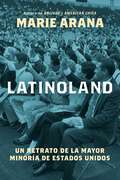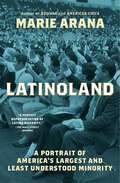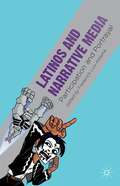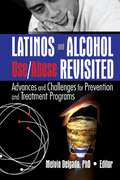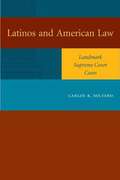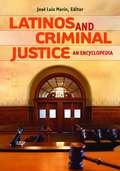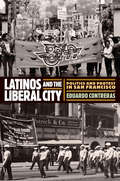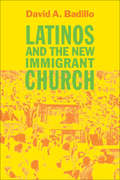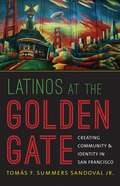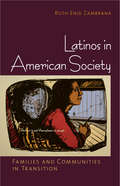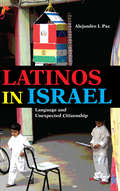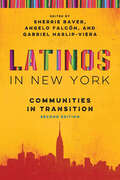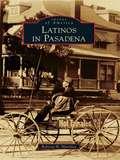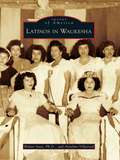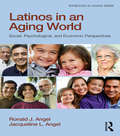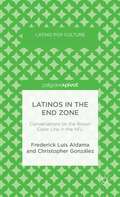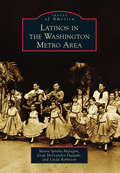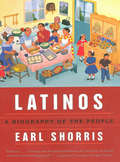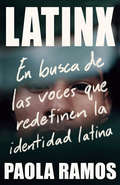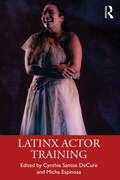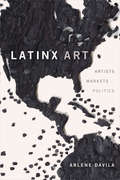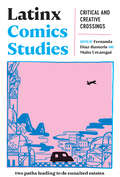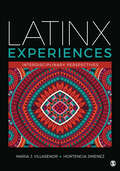- Table View
- List View
LatinoLand (Spanish Edition): Un retrato de la mayor minoría de Estados Unidos
by Marie Arana&“Perfecta representación de la diversidad latina&” (The Washington Post), LatinoLand se nutre de cientos de entrevistas y de una prodigiosa investigación para ofrecernos tanto un vibrante retrato como la poco conocida historia de nuestra minoría más numerosa y de más rápido crecimiento, en &“una obra de profecía, simpatía y coraje&” (Junot Díaz, autor ganador del Premio Pulitzer).LatinoLand constituye una excepcional y completa panorámica de la América hispana basada en entrevistas personales, una profunda investigación y la experiencia vital de Marie Arana como latina. Hoy en día, los latinos representan el veinte por ciento de la población de Estados Unidos, cifra que sigue en aumento. Para 2050, los informes del censo prevén que uno de cada tres estadounidenses será de ascendencia latina. Pero los latinos no son un monolito. No representan a un único grupo. Los más numerosos son los mexicanos, puertorriqueños, dominicanos, salvadoreños y cubanos. Cada uno tiene un trasfondo cultural y político diferente. Los puertorriqueños, por ejemplo, son ciudadanos estadounidenses, mientras que algunos mexicano-estadounidenses nunca emigraron debido a que la frontera entre Estados Unidos y México se desplazó tras la invasión estadounidense de 1848, incorporando lo que hoy es todo el suroeste de Estados Unidos. Los cubanos llegaron en dos grandes oleadas: la de quienes escaparon del comunismo en los primeros años de Castro, muchos de los cuales eran profesionales y ricos, y la de los salieron con permiso en el éxodo del Mariel veinte años después, que representaban a algunos de los cubanos más pobres, incluso los presos. Como lo muestra LatinoLand, los latinos fueron de los primeros inmigrantes que llegaron a lo que hoy es Estados Unidos, algunos en el siglo XVI. Racialmente son diversos: una mezcla aleatoria de blancos, negros, indígenas y asiáticos. Alguna vez abrumadoramente católicos, entre ellos hay cada vez más protestantes y evangélicos. Abarcan desde empleadas domésticas y jornaleros hasta artistas de éxito, directivos de empresas y senadores estadounidenses. Antes demócratas en su mayoría, ahora votan cada vez más por los republicanos. En lo cultural son tan variados como cualquier inmigrante de Europa o Asia.
LatinoLand: A Portrait of America's Largest and Least Understood Minority
by Marie Arana&“A perfect representation of Latino diversity&” (The Washington Post), LatinoLand draws from hundreds of interviews and prodigious research to give us both a vibrant portrait and the little-known history of our largest and fastest-growing minority, in &“a work of prophecy, sympathy, and courage&” (Junot Díaz, Pulitzer Prize–winning author).LatinoLand is an exceptional, all-encompassing overview of Hispanic America based on personal interviews, deep research, and Marie Arana&’s life experience as a Latina. At present, Latinos comprise twenty percent of the US population, a number that is growing. By 2050, census reports project that one in every three Americans will claim Latino heritage. But Latinos are not a monolith. They do not represent a single group. The largest groups are Mexicans, Puerto Ricans, Dominicans, Salvadorans, and Cubans. Each has a different cultural and political background. Puerto Ricans, for example, are US citizens, whereas some Mexican Americans never immigrated because the US-Mexico border shifted after the US invasion of 1848, incorporating what is now the entire southwest of the United States. Cubans came in two great waves: those escaping communism in the early years of Castro, many of whom were professionals and wealthy, and those permitted to leave in the Mariel boat lift twenty years later, representing some of the poorest Cubans, including prisoners. As LatinoLand shows, Latinos were some of the earliest immigrants to what is now the US—some of them arriving in the 1500s. They are racially diverse—a random infusion of white, Black, indigenous, and Asian. Once overwhelmingly Catholic, they are becoming increasingly Protestant and Evangelical. They range from domestic workers and day laborers to successful artists, corporate CEOs, and US senators. Formerly solidly Democratic, they now vote Republican in growing numbers. They are as culturally varied as any immigrants from Europe or Asia. Marie Arana draws on her own experience as the daughter of an American mother and Peruvian father who came to the US at age nine, straddling two worlds, as many Latinos do. &“Thorough, accessible, and necessary&” (Ms. magazine), LatinoLand unabashedly celebrates Latino resilience and character and shows us why we must understand the fastest-growing minority in America.
Latinos And Narrative Media
by Frederick Luis AldamaThis is the first book to explore the multitude of narrative media forms created by and that feature Latinos in the twenty-first century - a radically different cultural landscape to earlier epochs. The essays present a fresh take informed by the explosion of Latino demographics and its divergent cultural tastes.
Latinos and Alcohol Use/Abuse Revisited: Advances and Challenges for Prevention and Treatment Programs
by Melvin DelgadoThe one-of-a-kind exploration of effective alcohol prevention and treatment for Latinos-now and for the future!By the year 2020, the Latino population in the United States will increase to 60 million, making up 18 percent of all residents. Latinos and Alcohol Use/Abuse Revisited: Advances and Challenges for Prevention and Treatment Programs brings into sharp focus how present and future demographic shifts in Latino population are being felt in alcohol programs across the United States. Case studies and in-depth research clearly illustrate the practical steps various culturally competent programs recommend to effectively deal with alcohol use, prevention, and treatment for Latinos.Alcohol abuse, though rampant in Latino populations, has not received the attention that other types of drug abuse has received, even though the death rates, health problems, and financial costs from alcohol are staggering. Latinos and Alcohol Use/Abuse Revisited presents respected authorities tackling the tough questions about demographics, culturally competent research, and effective prevention and treatment programs. The book provides an up-to-date socio-demographic foundation, then builds upon current research and information to present a clear picture of the needs of various Latino populations for alcohol abuse programs now and in the future.Latinos and Alcohol Use/Abuse Revisited discusses: the Latino demographic profile-an overview patterns of need and treatment among Mexican-origin adults in central California alcohol abuse among Dominican-Americans the onset of alcohol and other drug use among gang members incarcerated Latinas, alcohol, and other drug abuse rural Latino grandparents raising grandchildren of substance abusing parents alcohol use among Puerto Rican active injecting drug users alcohol and other drug abuse prevention for high-risk youth a case study of a Puerto Rican community in Massachusetts detailed recommendations for prevention and treatmentLatinos and Alcohol Use/Abuse Revisited is a detailed examination of prevention and treatment programs for Latinos, invaluable for substance abuse professionals, social workers, practitioners, and professionals in charge of alcohol prevention and treatment programs.
Latinos and American Law: Landmark Supreme Court Cases
by Carlos R. SolteroTo achieve justice and equal protection under the law, Latinos have turned to the U.S. court system to assert and defend their rights. Some of these cases have reached the United States Supreme Court, whose rulings over more than a century have both expanded and restricted the legal rights of Latinos, creating a complex terrain of power relations between the U.S. government and the country's now-largest ethnic minority. <P><P>To map this legal landscape, Latinos and American Law examines fourteen landmark Supreme Court cases that have significantly affected Latino rights, from Botiller v. Dominguez in 1889 to Alexander v. Sandoval in 2001. Carlos Soltero organizes his study chronologically, looking at one or more decisions handed down by the Fuller Court (1888-1910), the Taft Court (1921-1930), the Warren Court (1953-1969), the Burger Court (1969-1986), and the Rehnquist Court (1986-2005). For each case, he opens with historical and legal background on the issues involved and then thoroughly discusses the opinion(s) rendered by the justices. He also offers an analysis of each decision's significance, as well as subsequent developments that have affected its impact. Through these case studies, Soltero demonstrates that in dealing with Latinos over issues such as education, the administration of criminal justice, voting rights, employment, and immigration, the Supreme Court has more often mirrored, rather than led, the attitudes and politics of the larger U.S. society.
Latinos and Criminal Justice: An Encyclopedia
by José MorínThis unique compilation of essays and entries provides critical insights into the Latino/a experience with the U.S. criminal justice system. Topical essays that provide context to major contemporary issues, such as immigrants and crime, drugs, youth, U.S.-Mexico border crime, policing, and prisons. Shorter, A–Z entries on a wide range of additional topics. Extensive bibliographies identifying further readings in the subject area.
Latinos and the Liberal City: Politics and Protest in San Francisco (Politics and Culture in Modern America)
by Eduardo ContrerasThe "Latino vote" has become a mantra in political media, as journalists, pundits, and social scientists regularly weigh in on Latinos' loyalty to the Democratic Party and the significance of their electoral participation. But how and why did Latinos' liberal orientation take hold? What has this political inclination meant—and how has it unfolded—over time?In Latinos and the Liberal City, Eduardo Contreras addresses these questions, offering a bold, textured, and inclusive interpretation of the nature and character of Latino politics in America's shifting social and cultural landscape. Contreras argues that Latinos' political life and aspirations have been marked by diversity and contestation yet consistently influenced by the ideologies of liberalism and latinidad: while the principles of activist government, social reform, freedom, and progress sustained liberalism, latinidad came to rest on promoting unity and commonality among Latinos.Contreras centers this compelling narrative on San Francisco—America's liberal city par excellence—examining the role of its Latino communities in local politics from the 1930s to the 1970s. By the early twentieth century, San Francisco's residents of Latin American ancestry traced their heritage to nations including Mexico, Puerto Rico, Nicaragua, El Salvador, Chile, and Peru. These communities formed part of the New Deal coalition, defended workers' rights with gusto, and joined the crusade for racial equality decades before the 1960s. In the mid- to late postwar era, Latinos expanded claims for recognition and inclusion while participating in movements and campaigns for socioeconomic advancement, female autonomy, gay liberation, and rent control. Latinos and the Liberal City makes clear that the local public sphere nurtured Latinos' political subjectivities and that their politicization contributed to the vibrancy of San Francisco's political culture.
Latinos and the New Immigrant Church
by David A. BadilloLatin Americans make up the largest new immigrant population in the United States, and Latino Catholics are the fastest-growing sector of the Catholic Church in America. In this book, historian David A. Badillo offers a history of Latino Catholicism in the United States by looking at its growth in San Antonio, Chicago, New York, and Miami. Focusing on twentieth-century Latino urbanism, Badillo contrasts broad historic commonalities of Catholic religious tradition with variations of Latino ethnicity in various locales. He emphasizes the contours of day-to-day life as well as various aspects of institutional and lived Catholicism. The story of Catholicism goes beyond clergy and laity; it entails the entire urban experience of neighborhoods, downtown power seekers, archdiocesan movers and shakers, and a range of organizations and associations linked to parishes. Although parishes remain the key site for Latino efforts to build individual and cultural identities, Badillo argues that one must consider simultaneously the triad of parish, city, and ethnicity to fully comprehend the influence of various Latino populations on both Catholicism and the urban environment in the United States.By contrasting the development of three distinctive Latino communities—the Mexican Americans, Puerto Ricans, and Cuban Americans—Badillo challenges the popular concept of an overarching "Latino experience" and offers instead an integrative approach to understanding the scope, depth, and complexity of the Latino contribution to the character of America's urban landscapes.
Latinos at the Golden Gate
by Tomás F. Summers SandovalBorn in an explosive boom and built through distinct economic networks, San Francisco has a cosmopolitan character that often masks the challenges migrants faced to create community in the city by the bay. Latin American migrants have been part of the city's story since its beginning. Charting the development of a hybrid Latino identity forged through struggle--latinidad--from the Gold Rush through the civil rights era, Tomas F. Summers Sandoval Jr. chronicles the rise of San Francisco's diverse community of Latin American migrants. This latinidad, Summers Sandoval shows, was formed and made visible on college campuses and in churches, neighborhoods, movements for change, youth groups, protests, the Spanish-language press, and business districts. Using diverse archival sources, Summers Sandoval gives readers a panoramic perspective on the transformation of a multinational, multigenerational population into a visible, cohesive, and diverse community that today is a major force for social and political activism and cultural production in California and beyond.
Latinos in American Society: Families and Communities in Transition
by Ruth Enid ZambranaIt is well known that Latinos in the United States bear a disproportionate burden of low educational attainment, high residential segregation, and low visibility in the national political landscape. In Latinos in American Society, Ruth Enid Zambrana brings together the latest research on Latinos in the United States to demonstrate how national origin, age, gender, socioeconomic status, and education affect the well-being of families and individuals. By mapping out how these factors result in economic, social, and political disadvantage, Zambrana challenges the widespread negative perceptions of Latinos in America and the single story of Latinos in the United States as a monolithic group. Synthesizing an increasingly substantial body of social science research much of it emerging from the interdisciplinary fields of Chicano studies, U. S. Latino studies, critical race studies, and family studies the author adopts an intersectional "social inequality lens" as a means for understanding the broader sociopolitical dynamics of the Latino family, considering ethnic subgroup diversity, community context, institutional practices, and their intersections with family processes and well-being. Zambrana, a leading expert on Latino populations in America, demonstrates the value of this approach for capturing the contemporary complexity of and transitions within diverse U. S. Latino families and communities. This book offers the most up-to-date portrait we have of Latinos in America today. "
Latinos in Israel: Language and Unexpected Citizenship (Public Cultures of the Middle East and North Africa)
by Alejandro I PazLatinos in Israel charts the unexpected ways that non-citizen immigrants become potential citizens. In the late 1980s Latin Americans of Christian background started arriving in Israel as labor migrants. Alejandro Paz examines the ways they perceived themselves and were perceived as potential citizens during an unexpected campaign for citizenship in the mid-2000s. This ethnographic account describes the problem of citizenship as it unfolds through language and language use among these Latinos both at home and in public life, and considers the different ways by which Latinos were recognized as having some of the qualities of citizens. Paz explains how unauthorized labor migrants quickly gained certain limited rights, such as the right to attend public schools or the right to work. Ultimately engaging Israelis across many such contexts, Latinos, especially youth, gained recognition as citizens to Israeli public opinion and governing politics. Paz illustrates how language use and mediatized interaction are under-appreciated aspects of the politics of immigration, citizenship, and national belonging.
Latinos in New York: Communities in Transition (Latino Perspectives Ser.)
by Sherrie BaverSignificant changes in New York City's Latino community have occurred since the first edition of Latinos in New York: Communities in Transition was published in 1996. The Latino population in metropolitan New York has increased from 1.7 million in the 1990s to over 2.4 million, constituting a third of the population spread over five boroughs. Puerto Ricans remain the largest subgroup, followed by Dominicans and Mexicans; however, Puerto Ricans are no longer the majority of New York's Latinos as they were throughout most of the twentieth century.Latinos in New York: Communities in Transition, second edition, is the most comprehensive reader available on the experience of New York City's diverse Latino population. The essays in Part I examine the historical and sociocultural context of Latinos in New York. Part II looks at the diversity comprising Latino New York. Contributors focus on specific national origin groups, including Ecuadorians, Colombians, and Central Americans, and examine the factors that prompted emigration from the country of origin, the socioeconomic status of the emigrants, the extent of transnational ties with the home country, and the immigrants' interaction with other Latino groups in New York. Essays in Part III focus on politics and policy issues affecting New York's Latinos. The book brings together leading social analysts and community advocates on the Latino experience to address issues that have been largely neglected in the literature on New York City. These include the role of race, culture and identity, health, the criminal justice system, the media, and higher education, subjects that require greater attention both from academic as well as policy perspectives.Contributors: Sherrie Baver, Juan Cartagena, Javier Castaño, Ana María Díaz-Stevens, Angelo Falcón, Juan Flores, Gabriel Haslip-Viera, Ramona Hernández, Luz Yadira Herrera, Gilbert Marzán, Ed Morales, Pedro A. Noguera, Rosalía Reyes, Clara E. Rodríguez, José Ramón Sánchez, Walker Simon, Robert Courtney Smith, Andrés Torres, and Silvio Torres-Saillant.
Latinos in Pasadena (Images of America)
by Roberta H. MartinezHistories of Pasadena are rich in details about important citizens, time-honored traditions, and storied enclaves such as Millionaires Row and Lamanda Park. But the legacies of Mexican Americans and other Latino men and women who often worked for Pasadena's rich and famous have been sparsely preserved through the generations--even though these citizens often made remarkable community contributions and lived in close proximity to their employers. A fuller story of the Pasadena area can be provided from these vintage images and the accompanying information culled from anecdotes, master's theses, newspaper articles, formal and informal oral histories, and the Ethnic History Research Project compiled for the City of Pasadena in 1995. Among the stories told is that of Antonio F. Coronel, a one-time Mexican Army officer who served as California state treasurer from 1866 to 1870 and whose image graced the 1904 Tournament of Roses program.
Latinos in Waukesha (Images of America)
by Walter Sava Anselmo VillarrealWaukesha's Latino community continues to keep pace with the growth that has characterized Latino demographics in the last 20 years. About 15,000 Latinos are now Waukesha County residents, and there are very unique qualities ascribed to this community. A significant number of Latinos can trace their Waukesha roots to the early 1920s and 1930s. The vast majority of Latinos who came to Waukesha ended up working in foundries, and a significant number retired from those jobs. There are now many families who are third- and fourth-generation Latinos, and new arrivals continue to join friends and relatives already established in Waukesha.
Latinos in an Aging World: Social, Psychological, and Economic Perspectives (Textbooks in Aging)
by Ronald J. Angel Jacqueline L. AngelThis book fosters a deeper understanding of the growing Latino elderly population and the implications on society. It examines post-WWII demographic and social changes and summarizes research from sociology, psychology, economics, and public health to shed light on the economic, physical, and mental well-being of older Latinos. The political and cultural implications including possible policy changes are also considered. Written in an engaging style, each chapter opens with a vignette that puts a human face on the issues. Boxed exhibits highlight social programs and policies and physical and mental health challenges that impact Latino elders. Web alerts direct readers to sites that feature more detailed information related to the chapter’s issues. Each chapter also features an introduction, examples, tables, figures, a summary, and discussion questions. The self-contained chapters can be presented in any order. Latinos in an Aging World explores: Real world problems individuals face in dealing with poverty, immigration, and health and retirement decisions The latest data on Latinos as compared to research on African- and Asian- Americans where appropriate The unique historical, demographic, social, familial, and economic situations of various Latino subgroups including those from Mexico, Puerto Rico, and Cuba How ethnicity affects one’s position of wealth and power and sense of citizenship. The consequence of life-long disadvantages and stigmatization on economic, physical, and mental well-being The impact of one’s neighborhood and the proximity to those from similar cultures on quality of life. The introduction motivates the book and sets the stage for the entire discussion. Chapter 1 reviews the histories of the major Hispanic subgroups along with various theories as they relate to race, ethnicity, and gender that provide a conceptual framework for understanding the later chapters. Demographic, economic, and social profiles of the various Hispanic subgroups are explored in chapter 2. Next the Latino population is explored from various perspectives including the economic and social situations of men and women and their educational, marital and family, and labor force experiences. Chapter 4 examines older immigrants and their families and identifies the resources available to them in their communities that often replicate the cultural and social support system of the old country. Major health risks that older Latinos face as a result of the disadvantages they experience throughout life are examined in chapter 5. Family situations and long-term care and living arrangements of older Hispanics are examined in chapter 6. The impact of neighborhood on quality of life in terms of safety and physical and mental wellbeing is explored in chapter 7. The burden that eldercare can place upon those who bear the responsibility of their daily care is explored in chapter 8. Chapter 9 investigates the gaps in income between minority and non-Hispanic white Americans and reviews what individuals with few resources need to know about financial management. The book concludes with the social, political, and economic implications of the growing Hispanic population and the role of NGOs and other organizations in providing services to older populations. Intended for courses on Latinos and aging, diversity, race and ethnicity, minorities and aging, adult development and aging, the psychology or sociology or politics of aging, geriatric social work, public health and aging, global aging, social or family policy, and health and society taught in the behavioral and social sciences, ethnic, or Latin American/Chicano Studies, this book also appeals to researchers and practitioners who work with Hispanic families.
Latinos in the End Zone: Conversations on the Brown Color Line in the NFL
by Frederick Luis Aldama Christopher GonzálezFrederick Luis Aldama and Christopher Gonzalez offer a thought-provoking conversation on the history of Latinos in the pro football leagues. As they weave their way through significant points where culture, politics, and history congeal, Aldama and Gonzalez thread together an alpha-to-omega, all-encompassing story of Latinos in the NFL.
Latinos in the Legislative Process
by Stella M. RouseIn one of the only accounts of Latino legislative behavior, Stella M. Rouse examines how well the growing Latino population translates their increased presence into legislative influence. Latinos in the Legislative Process explores Latino representation by considering the role of ethnicity throughout the legislative process - from bill sponsorship, to committee deliberations, to floor votes - in seven state legislatures. Rouse first identifies issues that are priorities for Latinos and tells us whether a Latino political agenda exists. She then provides a theoretical framework for ethnicity in legislative behavior and outcomes. Rouse demonstrates that ethnicity is a complex dynamic that plays a variable role in the legislative process. Thus, Latino representation cannot be viewed monolithically.
Latinos in the Washington Metro Area (Images of America)
by Linda Robinson Jorge Hernandez-Fujigaki Maria Sprehn-MalagónThe Latino presence in the Washington, DC, metropolitan area has diverse roots and a rich history. The earlier residents were relatively small in number, but the Latino population increased dramatically in the late 20th century. Today, this unique Latino community is the 12th largest in the nation. While people of Salvadoran origin are the most numerous, this area is also home to those who hail from Mexico, Puerto Rico, Guatemala, Cuba, the Dominican Republic, Bolivia, Argentina, Chile, Colombia, Ecuador, Honduras, Nicaragua, Paraguay, Peru, Spain, Uruguay, and many other nations and cultures. This book highlights the early days of the Hispanic Festival, the Central American peace movement, the struggle for civil and immigrants� rights, and notable residents. With a shared immigrant experience and broad cultural bonds, these and many other Latino residents have transformed the Washington, DC, area.
Latinos: A Biography of the People
by Earl ShorrisEarl Shorris's deeply moving narrative enlivened by biographical sketches of Mexican Americans, Cuban Americans, Puerto Ricans, and many others struggling with the burden of a rich and terrible history illuminates every aspect of the Latino experience in America, from language to education to social and political organization.
Latinos: A Biography of the People
by Earl ShorrisThey are sometimes called the people who died twice, once at the hands of the Spaniards and their brutal process of civilization, then at the hands of Anglos, practicing a subtler exploitation. They are Latinos, the fastest-growing minority in the United States. Earl Shorris's deeply moving narrative—enlivened by biographical sketches of Mexican Americans, Cuban Americans, Puerto Ricans, and many others struggling with the burden of a rich and terrible history—illuminates every aspect of the Latino experience in America, from language to education to social and political organization.
Latinx
by Paola RamosEl primer paso hacia el cambio es reconocer que nuestro poder nace de nuestra identidad. Los jóvenes latinos en los Estados Unidos están redefiniendo su identidad, rompiendo moldes establecidos, y despertando políticamente de maneras sorprendentes y poderosas. Muchos de ellosafrolatinos, indígenas, musulmanes, queer e indocumentados tanto en zonas urbanas como ruralesrepresentan voces históricamente ignoradas en el modo en que la diversa población de casi seis millones de latinos en los Estados Unidos ha sido representada. Hasta ahora. En esta inspiradora crónica de viaje de costa a costa, la periodista y activista Paola Ramos emprende una búsqueda de los individuos y comunidades que dan vida a un nuevo movimiento que esta definiendo el término controversial Latinx. Ramos nos presenta a un grupo de indígenas originarios de Oaxaca que ha reinventado la calle mayor de un pueblo industrial en el estado de Nueva York, a las Las Poderosas, que luchan por los derechos reproductivos en Texas, a unos músicos en Milwaukee que con sus ritmos confortan a otros sobre sus raíces... A lo largo de este viaje encontraremos también a activistas ambientales, trabajadores de campo, drag queens, e inmigrantes detenidos en la frontera. A partir de su trabajo periodístico sobre el terreno, así como de su historia personal, Ramos ilustra como el término Latinx ha dado paso a un sentimiento de pertenencia y solidaridad sin precedentes entre los latinos de este país. Relevante e inspirador, Latinx nos invita a expandir nuestra conciencia de lo que significa ser latino y ser estadounidense, y como ambas identidades conviven dentro y fuera de esta comunidad.
Latinx Actor Training
by Cynthia Santos DeCure Micha EspinosaLatinx Actor Training presents essays and pioneering research from leading Latinx practitioners and scholars in the United States to examine the history and future of Latino/a/x/e actor training practices and approaches. Born out of the urgent need to address the inequities in academia and the industry as Latinx representation on stage and screen remains disproportionately low despite population growth; this book seeks to reimagine and restructure the practice of actor training by inviting deep investigation into heritage and identity practices. Latinx Actor Training features contributions covering current and historical acting methodologies, principles, and training, explorations of linguistic identity, casting considerations, and culturally inclusive practices that aim to empower a new generation of Latinx actors and to assist the educators who are entrusted with their training. This book is dedicated to creating career success and championing positive narratives to combat pervasive and damaging stereotypes. Latinx Actor Training offers culturally inclusive pedagogies that will be invaluable for students, practitioners, and scholars interested in the intersections of Latinx herencia (heritage), identity, and actor training.
Latinx Art: Artists, Markets, and Politics
by Arlene DávilaIn Latinx Art Arlene Dávila draws on numerous interviews with artists, dealers, and curators to explore the problem of visualizing Latinx art and artists. Providing an inside and critical look of the global contemporary art market, Dávila's book is at once an introduction to contemporary Latinx art and a call to decolonize the art worlds and practices that erase and whitewash Latinx artists. Dávila shows the importance of race, class, and nationalism in shaping contemporary art markets while providing a path for scrutinizing art and culture institutions and for diversifying the art world.
Latinx Comics Studies: Critical and Creative Crossings (Critical Graphics)
by Marcel Brousseau Frederick Luis Aldama Terry Blas Héctor Fernández L’Hoeste Francisca Cárcamo Rojas Jessica Rutherford Stephanie Contreras Jennifer Caroccio Maldonado Nicky Rodriguez Katherine Kelp-Stebbins Kaitlin E. Thomas Héctor Rodriguez Katlin Marisol Sweeney-Romero Maite Urcaregui Breena Nuñez Fernanda Díaz-Basteris Lars Allen Conrado Parraguirre Jennifer Gómez Menjívar Nicole Ann Amato Jennifer Gómez-MenjivarLatinx Comics Studies: Critical and Creative Crossings offers an intersectional and interdisciplinary approach to analyzing Latinx studies and comics studies. The book draws together groundbreaking critical essays, practical pedagogical reflections, and original and republished short comics. The works in this collection discuss the construction of national identity and memory, undocumented narratives, Indigenous and Afro-Latinx experiences, multiracial and multilingual identities, transnational and diasporic connections, natural disasters and unnatural colonial violence, feminist and queer interventions, Latinx futurities, and more. Together, the critical and creative works in this collection begin to map out the emerging and evolving field of Latinx comics studies and to envision what might be possible in and through Latinx comics. This collection moves beyond simply cataloguing and celebrating Latinx representation within comics. It examines how comics by, for, and about Latinx peoples creatively and conceptually experiment with the very boundaries of “Latinx” and portray the diverse lived experiences therein.
Latinx Experiences: Interdisciplinary Perspectives
by Maria J. Villasenor Hortencia JimenezThis reader introduces students to the variety and complexity of Latinxs′ experiences in the U.S., and prepares them for further study in this interdisciplinary field. The opening essay, written by the editors, offers a broad overview of the approximately 59 million people in the U.S. who identify as Hispanic. The rest of the book will consist of contributed essays from Latina(o)/Chicana(o) scholars on a range of subjects including immigration, citizenship, and deportation; racial identities; political participation and power; educational and economic achievement; family; religion; media and popular culture. Although the essays are written for lower-division undergraduates, they reflect many of the leading theoretical and methodological approaches in the field. The essays are unified by an intersectional approach, demonstrating how experiences and life chances of Latinxs are also shaped by gender, social class, sexuality, age, and citizenship status.
